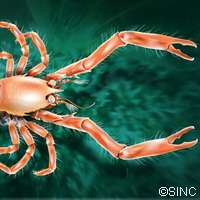New reclusive crab species found tucked away on Galician seabed

Although it might seem like we have an extensive record of all the species we share the planet with, there are plenty left to be discovered who have long eluded humans' cataloguing efforts.
Case in point: Uroptychus cartesi, a new species of crab found at a depth of more than 1 410 meters on the underwater mountain Banco de Galicia, just off the Galician coast in Spain. The newly discovered crab measures between just 5 cm and 7 cm.
The deep-sea finding was made as part of the INDEMARES ('Inventory and designation of marine Natura 2000 areas in the Spanish sea') project. INDEMARES is partly funded to the tune of EUR 7.7 million by the European Commission, as part of the EU's 'LIFE+' programme under the 'Environment' Thematic area.
This crab's morphological characteristics make it unique to the easternmost corner of the Atlantic, and it differs from most European species due to its shape and the number of thorns on its shell. It has much more in common with its Caribbean cousin: Uroptychus armatus.
Writing in the journal Zootaxa, the researchers, from Japan and Spain, explain that the Uroptychus cartesi crab belongs to the Chirostylidae family and is one of a mere four family members living in Europe. Fourteen other Uroptychus cartesi closest family members prefer frequenting Caribbean waters over European ones, and 100 other types exist in the Indo-Pacific ocean.
Study co-author, Enrique Macpherson from the Centre for Advanced Studies of Blanes (CEAB-CSIC), Spain, comments: "Its closeness to species from the Caribbean is logical. All North Atlantic species have common features and are likely to have come from shared ancestry, who invaded the Atlantic from the Pacific and Indian Ocean a few million years ago."
Macpherson adds that the small orange-coloured squat lobster usually lives around deep corals and gorgonians, and tends to be abundant in submarine mountains and canyons that have been subject to little fishing.
Despite not bearing any resemblance to them, this squat lobster belongs to the group of hermit crabs. Researchers have verified that their larvae have a low dispersion capacity, given that they spend very few days in the planktonic stage. It seems that they like to feed on small crustaceans and particulate matter.
The main objective of the INDEMARES project is to contribute to the protection and sustainable use of biodiversity in the Spanish seas, through the identification of valuable areas for the Natura 2000 network. This EU-wide network comprises areas of conservation and protection for Europe's most important and threatened species and habitats, and includes the marine environment.
More information: Baba, K., et al., 'A new squat lobster (Crustacea: Decapoda: Anomura: Chirostylidae) from off NW Spain', Zootaxa, 3224: 49-56, 2012.
Journal information: Zootaxa
Provided by CORDIS



















